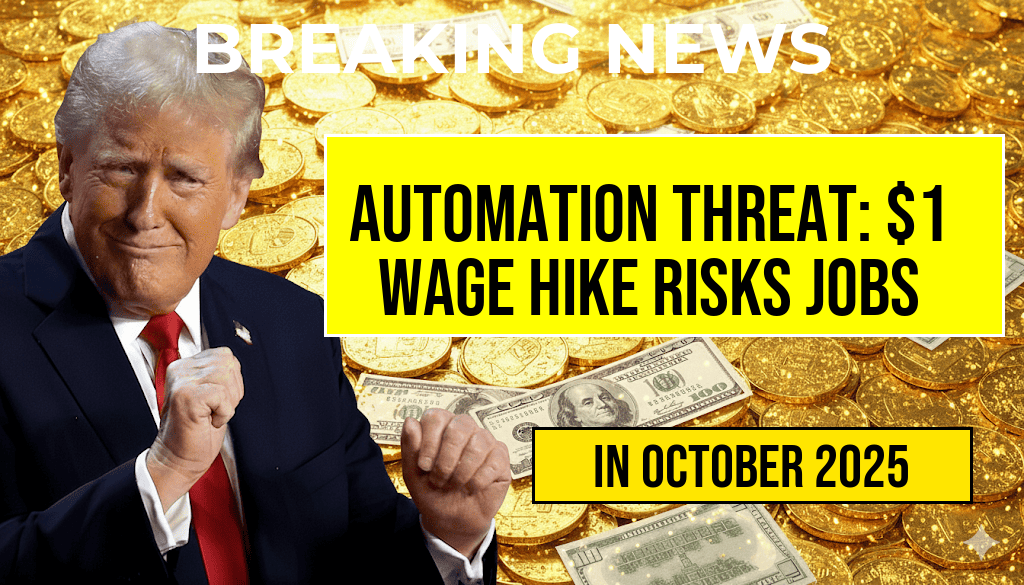Small business owners across the United States are grappling with a complex dilemma as recent discussions about raising the minimum wage gain momentum. A proposed increase of just $1 per hour, seemingly modest on the surface, could have disproportionate repercussions for small enterprises, many of which operate with razor-thin profit margins. While such wage hikes aim to improve workers’ living standards, they also threaten to escalate labor costs significantly, potentially compelling small businesses to make difficult decisions—including reducing staff, cutting hours, or delaying expansion plans. Experts warn that this incremental wage increase might act as a catalyst for automation adoption, further transforming the landscape of employment in sectors heavily reliant on low-wage labor. As policymakers debate the merits of raising the minimum wage, small business owners are voicing concerns about the tangible operational challenges that could ensue.
Understanding the Impact of a $1 Wage Increase on Small Businesses
Profit Margins Under Pressure
Small businesses, which account for approximately 44% of U.S. economic activity according to the Wikipedia entry on small businesses, often operate with narrow profit margins. An increase in hourly wages by just $1 can accumulate rapidly across multiple employees, especially in sectors like retail, hospitality, and food service. For example, a restaurant with 20 employees working 30 hours weekly would face an additional payroll expense of roughly $600 per week, or about $2,400 per month. When scaled across numerous small firms, these costs can threaten financial viability, prompting owners to reevaluate staffing strategies.
Potential Workforce Reductions
Labor cost increases may lead small business owners to consider reducing their workforce or limiting hiring. According to a recent survey by the National Federation of Independent Business (NFIB), nearly 35% of small business owners reported that rising wages could lead to layoffs or reduced hours for existing employees. While some firms might absorb the costs temporarily, many view layoffs as a necessary step to preserve long-term sustainability, especially if they operate in highly competitive markets with limited pricing power.
Automation as a Cost-Effective Alternative
As labor costs climb incrementally, automation becomes increasingly attractive for small businesses seeking to maintain profitability. Technologies such as self-service kiosks, automated checkout systems, and robotic process automation for tasks like inventory management are gaining traction. Industry analysts suggest that even a modest wage increase can tip the cost-benefit analysis in favor of automation, especially for repetitive tasks. A report by Forbes highlights how small retailers and restaurants are investing in automation tools to offset rising wages, potentially reducing dependence on low-wage staff altogether.
Economic and Social Considerations
Balancing Worker Welfare and Business Sustainability
Advocates for increasing the minimum wage argue that higher earnings improve workers’ quality of life and stimulate local economies. The Economic Policy Institute emphasizes that even small wage increases can significantly reduce poverty among low-income workers. However, small business owners worry about the unintended consequences of such policies—particularly if wage hikes lead to employment reductions or increased automation, which could diminish job opportunities for low-skilled workers.
Regional Variations and Policy Implications
The impact of a $1 wage increase is likely to vary depending on regional economic conditions. For instance, in high-cost metropolitan areas like New York or San Francisco, where the minimum wage already exceeds federal levels, further increases may exert less strain. Conversely, in rural or economically vulnerable regions, even small wage hikes could threaten the viability of some small businesses. Policymakers face the challenge of tailoring wage policies that promote fair compensation without inadvertently harming employment prospects in small communities.
Data and Projections
| Sector | Estimated Additional Weekly Labor Cost per 10 Employees | Potential Staff Reduction Risk |
|---|---|---|
| Retail | $300 | Moderate |
| Hospitality | $250 | High |
| Food Service | $400 | High |
These figures illustrate the potential financial pressures small businesses face, which could force staff reductions if revenues do not increase proportionately. Industry experts suggest that the actual impact will depend heavily on a business’s ability to pass costs onto consumers and its operational flexibility.
Looking Ahead: Navigating the Wage Debate
As discussions about incremental wage hikes continue, small business owners are calling for balanced policies that consider their unique challenges. Some propose targeted support measures, such as tax credits or grants, to offset increased labor costs and facilitate investments in automation. Others emphasize the importance of phased wage increases, allowing businesses time to adapt without resorting to layoffs or closures.
The debate underscores a broader question about how to reconcile economic growth, worker well-being, and the sustainability of small enterprises. While a $1 wage increase might seem minor, its ripple effects highlight the delicate balance that small business owners must strike in an evolving economic landscape.
Frequently Asked Questions
What is the main concern regarding automation and small businesses?
The primary concern is that automation driven by low-cost labor, such as a one-dollar wage increase, could force small businesses to reduce their staff in order to stay competitive and maintain profitability.
How might a one-dollar wage increase impact small business employment?
A minimal wage increase can significantly raise operational costs for small businesses, potentially leading them to reduce staff or delay hiring to manage expenses and preserve profit margins.
Could automation serve as an alternative to staff reduction?
Yes, many small businesses might turn to automation as a cost-effective way to replace staff, especially if wage increases make human labor less economically viable.
What are the potential consequences for job security and employment rates?
Increased wage costs could lead to job cuts or reduced hiring, negatively impacting employment rates and job security for workers in small business sectors.
Are there any policies or solutions to mitigate the risks of automation replacing small business staff?
Policy measures such as wage subsidies, training programs, and support for technological adoption can help small businesses balance wage increases with employment stability.










